Ice fishing for crappie is a beloved winter pastime in the United States, particularly in the northern states, where the colder temperatures provide the perfect environment for these fish to thrive.
As the temperatures drop, crappie – specifically black crappie and white crappie – move to deeper waters in search of food and stable conditions.
For successful crappie ice fishing, understanding crappie behavior and habits in winter is key. During the early ice period, crappie can be found in shallow water near structures like weed beds and brush piles.
As winter progresses, they move to deeper waters, from 20 to 35 feet, seeking food sources like small fish, small invertebrates, and crappie bait – live minnows and wax worms.
Small jigs, tungsten jigs, or soft plastics tipped with live bait are effective lures during this season, as they mimic crappie’s primary winter food. Crappie are most active in early morning and late afternoon.
Technology such as fish finders, underwater cameras, or ice fishing flashers can help locate the best spots and the ideal depth for bait placement. Experimentation with different bait and lure combinations like horizontal jigs, small hooks, and tiny jigs with soft plastics can help attract the crappie.
Read on to learn how these crappie ice fishing tips will enhance your chances for a successful ice fishing season.
Crappie Ice Fishing Essentials
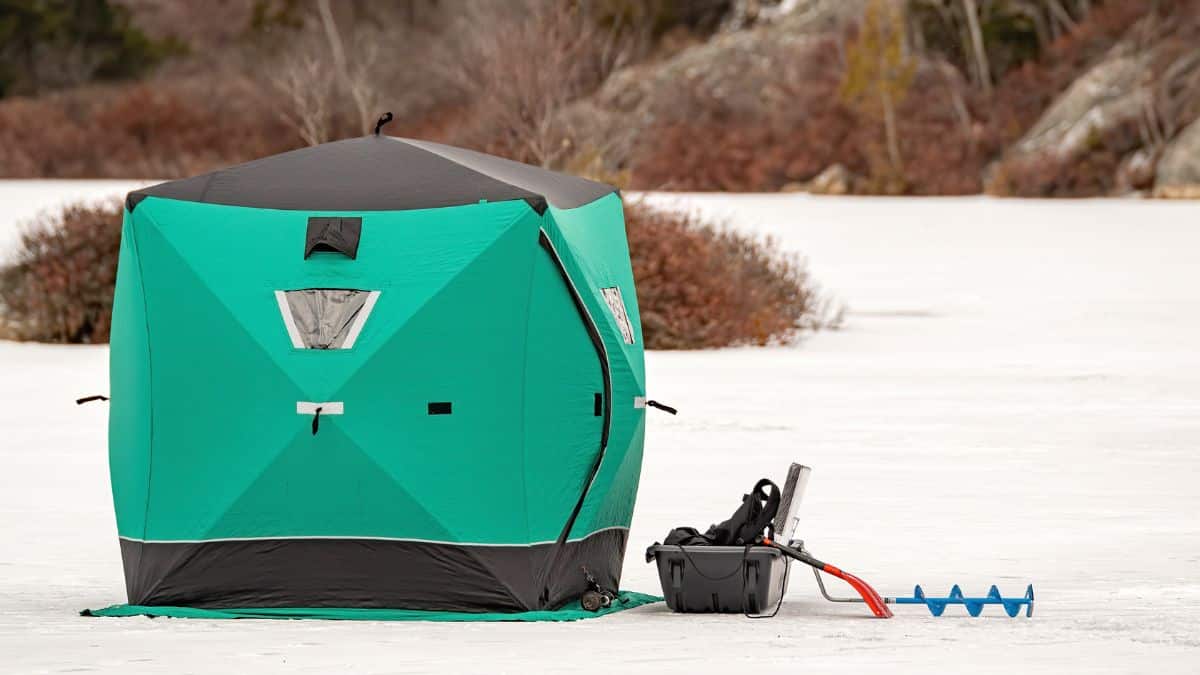
Selecting the Right Gear
Having the appropriate gear is crucial when embarking on a crappie ice-fishing adventure. Start by choosing an ice fishing rod designed for crappie fishing, as this will allow for better sensitivity when detecting bites.
Essential ice fishing tackle items include small jigs, tungsten jigs, and tiny spoons paired with live bait such as wax worms, live minnows, or small fish. Lastly, an ice auger, underwater camera, and ice fishing flasher can enhance your overall crappie ice fishing experience.
Choosing Ice Fishing Clothing
As crappie ice fishing takes place during the winter, it’s essential to wear appropriate clothing to stay warm and dry. Select waterproof, insulated layers, and remember essentials like gloves, hats, and thermal socks.
In colder regions, choose breathable clothing materials to wick away moisture and maintain proper body temperature out on the ice.
Setting Up an Ice Shelter
An ice shanty, sometimes known as an ice house, offers a sheltered, warm space for anglers to fish during the cold winter. When setting up an ice shanty, consider the following:
- Locate an excellent place to fish by targeting weed beds, deep holes, or any underwater structures holding crappie.
- Drill an ice hole of the appropriate size to accommodate fishing through it.
- Set up the ice shelter over the ice hole with proper space for your ice fishing gear, such as rod holders and heaters.
- Remain mobile between several locations, searching for schooling fish if crappie bites are sparse. Don’t hesitate to drill dozens of holes and utilize a portable ice shelter.
By following these crappie ice fishing essentials and adapting your strategy based on the time of year, size of the waterbody, and species of crappie (black or white), you will significantly improve your chances of success in the United States’ northern states and the Great Lakes region during the winter months.
Remember, researching local ice conditions, crappie hotspots, and the best ice fishing techniques for the area you plan to fish can provide valuable insight.
Scouting and Ice Fishing Locations
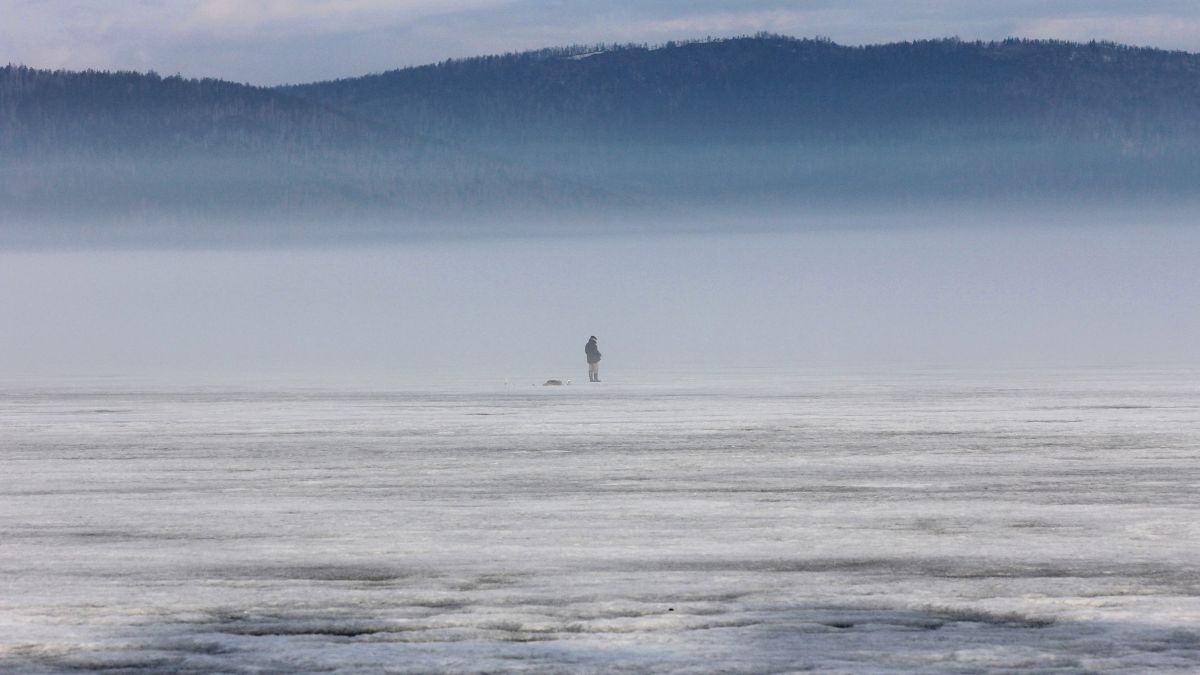
Identifying Productive Crappie Habitats
Ice fishing for crappie can be a challenging but rewarding experience. These panfish species typically inhabit areas with abundant vegetation, like weed beds, drop-offs, and channels.
However, crappie may move to shallower water near vegetation and channels during early ice and late ice. Look for submerged structures like brush piles, which can provide a good place for crappies to hide.
Using Electronics for Locating Fish
A fish finder or underwater camera can be a valuable tool when ice fishing for crappies:
- Fish finders can help identify deep holes, channels, and other structures where crappies may be hiding.
- Underwater cameras allow ice fishermen to inspect the aquatic environment in real-time, making it easier to locate schooling fish.
- Electronics can help you monitor the depth and temperature of the water column, making it simpler to find the crappie’s preferred habitat.
Safety and Navigation on Ice
When venturing out on the ice, it’s essential to prioritize safety and proper navigation. Consider the following points:
- Always check ice conditions before heading out. A minimum thickness of four inches is necessary for safe ice fishing.
- Use caution around areas with currents, open water, and near the shore since ice can be thinner and weaker in these locations.
- Use a GPS or a map and compass for efficient navigation and to mark productive ice fishing spots.
- Consider fishing with a buddy for added safety and assistance in an emergency.
Successful crappie ice fishing requires knowledge of the habitat preferences of the fish, proper use of electronics, and an uncompromising focus on safety. Combining these strategies will greatly increase your chances of locating and catching crappies during the ice fishing season.
Crappie Bait and Lure Selection
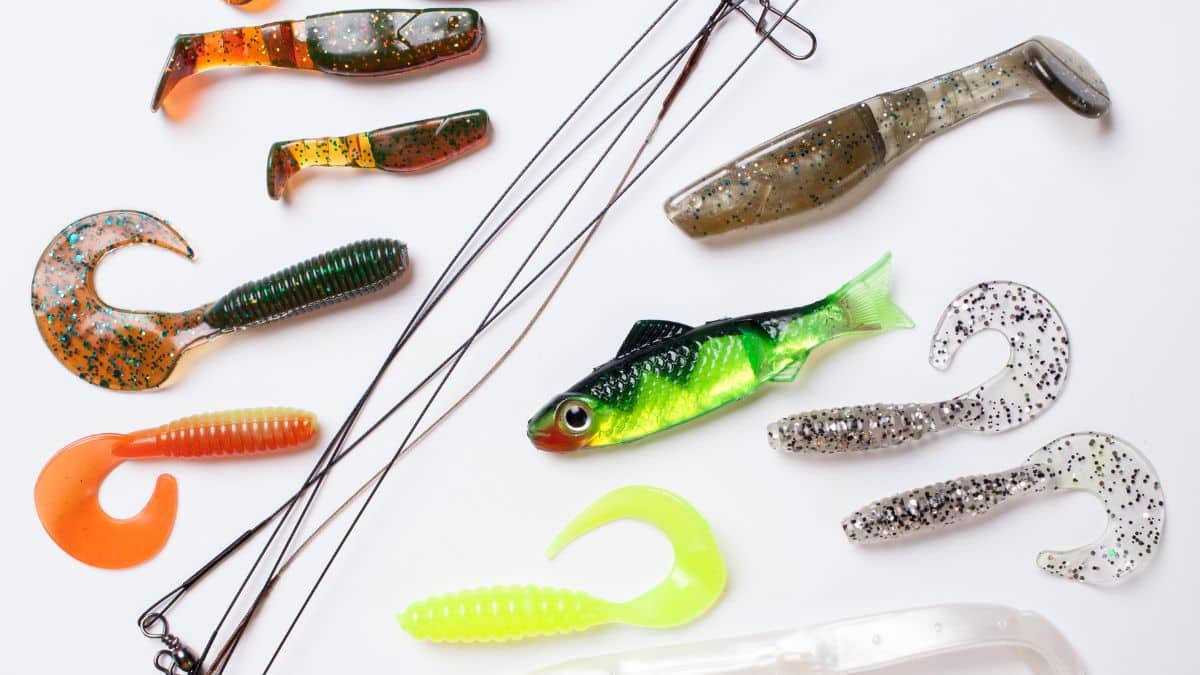
Choosing the right bait and lure is essential for success in crappie ice fishing. Next, we will discuss the types of live bait and artificial lures that are effective for catching both black and white crappie during winter.
Live Baits
Live baits are a popular choice for crappie ice fishing, as they closely resemble the small fish and invertebrates that crappie feed on in their natural environment. Minnows and wax worms are two common types of live bait used for catching crappie.
- Minnows: Live minnows are a great bait choice for crappie fishing, as they are a natural part of the crappie’s diet. Fathead minnows are often used due to their availability in the United States. Keeping live minnows healthy and active by providing adequate oxygen and maintaining proper water temperatures is essential.
- Wax worms: Wax worms are small invertebrates that crappie enjoy feeding on, especially within the water column. They can be found in shallow water environments and are often used with a small jig or hook to attract crappie.
Artificial Lures
Artificial lures can also be highly effective for ice fishing crappie. Many anglers choose to use soft plastics and tungsten jigs.
- Soft Plastics: Soft plastic lures are designed to mimic the small fish and invertebrates that crappie feed on. They come in various shapes, sizes, and colors, allowing you to tailor your lure selection to the specific conditions and time of year. Some popular soft plastic lures for crappie include small minnows, grub-style tails, and small jigs.
- Tungsten Jigs: Tungsten jigs are an excellent choice for crappie ice fishing, as they are heavier than traditional lead jigs and can sink faster and reach deeper water more easily. These jigs are available in a wide range of sizes, styles, and finishes and are often paired with soft plastics or live bait to entice crappie bites.
Both live bait and artificial lures can be effective for crappie ice fishing. It’s essential to consider factors like water clarity, depth, and crappie behavior when choosing the right bait or lure.
As a rule of thumb, live bait works well in murkier water, while artificial lures may be more effective in clear water. Crappies are often more attracted to live bait during early ice conditions, while artificial lures might be a better choice in deeper water as the ice fishing season progresses.
Ice Fishing Techniques for Crappie
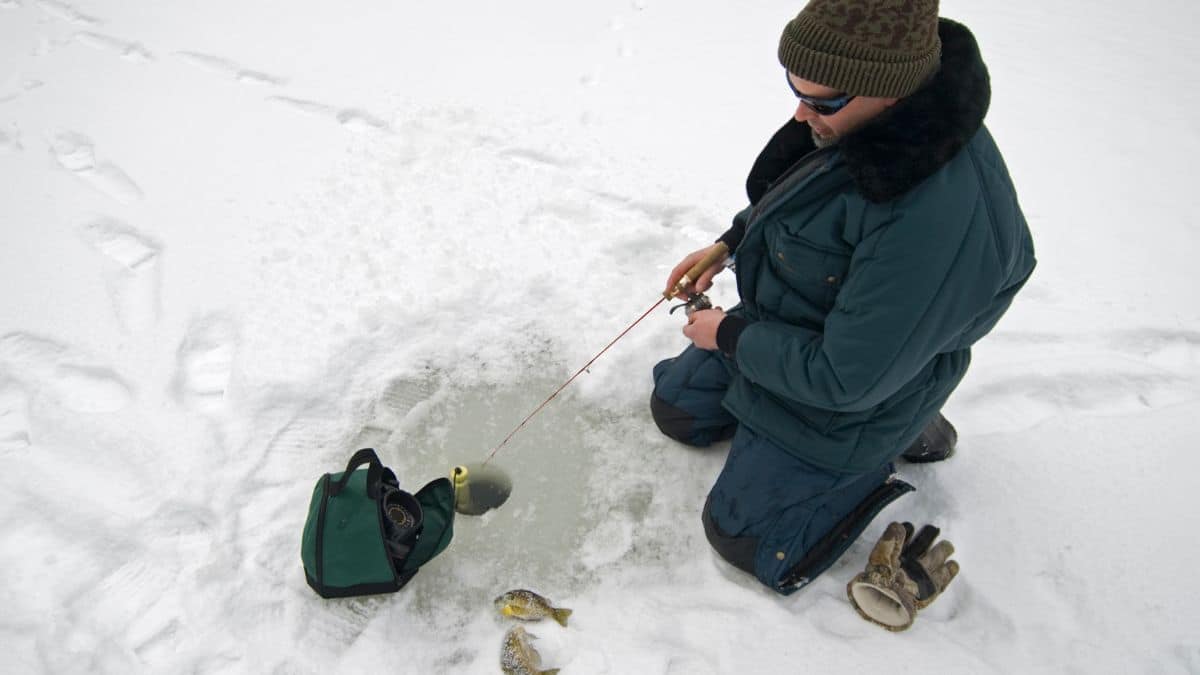
Hole Drilling and Location Strategy
Black crappie and white crappie can be found around weed beds, brush piles, and drop-offs in shallow and deeper water. Hole placement should target these areas, with holes drilled in both shallow and deeper water, to provide a range of options.
During early ice, crappie tends to stay in shallower water near their open water feeding grounds but move to deeper water as winter progresses.
Understanding fish behavior is crucial when drilling holes. Therefore, drilling plenty of holes near different structures and depths is wise to locate the most active fish.
Jigging and Lure Presentation
When ice fishing for crappie, jigging is the most effective method. Fishermen should use small jigs, tungsten jigs, and tiny spoons as their lure presentation. Light lines and small hooks, in combination with a sensitive ice fishing rod and spring bobber, can help detect subtle crappie bites.
Crappie diets mainly consist of small fish and invertebrates. Therefore, a good choice is to use live bait like small minnows, wax worms, or live minnows with soft plastic bodies.
When jigging, hold the rod steady and occasionally twitch the rod tip to impart slight movement onto the lure, keeping the prey’s presentation natural.
Fishing Guide: 13 Best Ice Fishing Crappie Jigs
Reading and Attracting Fish with Flasher
In addition to detecting fish, a flasher can help monitor how fish react to different lure presentation techniques and jigging motions.
When using a flasher, keep an eye on the water column and identify the strike zone where fish are most likely to bite. Species like crappie are most commonly found suspended, so it’s essential to present lures at the right depth to increase the chances of catching crappies in the strike zone.
Attracting crappie can be challenging in murky water or during night ice fishing. Using submersible or green lights can draw these fish closer, as they have excellent eyesight and are attracted to light.
By utilizing these hole-drilling strategies, jigging techniques, and employing a flasher, the chances of successful crappie ice fishing can be significantly increased.
Remember to adapt your approach based on the time of year, water depth, and weather conditions to find the optimal strategy for catching crappies.
Fishing Guide: 10 Best Ice Fishing Rods for Panfish
Adjustments for Varying Conditions
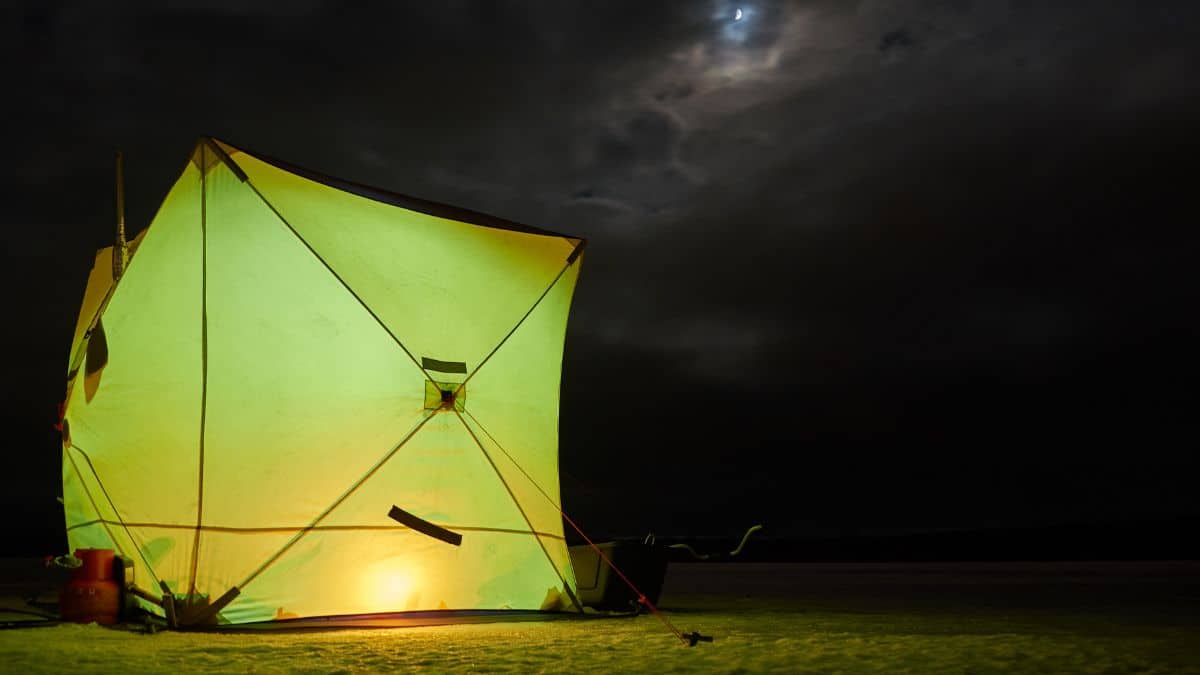
Fishing in Changing Light Conditions
Crappies are sensitive to light conditions, relying on their excellent eyesight to locate and capture prey. During low-light periods such as dawn, dusk, and heavy cloud cover, crappie often move to shallower water to hunt small invertebrates and baitfish.
Using an ice fishing flasher or fish finder, locate fish close to structures like weed beds, brush piles, and submerged objects where they are likely to hide.
Consider using horizontal jigs or small spoons tipped with live bait such as wax worms, small minnows, or soft plastics in these scenarios.
As the light conditions change throughout the day, crappie often retreat to deeper water.
In this case, adjust your fishing depth accordingly, and consider using an underwater camera to monitor the water column and find the strike zone.
Adapting to Water Temperature and Depth
Water temperature can have a significant impact on the movement and feeding habits of crappie.
During the colder winter months, crappie is typically found in deeper waters with high oxygen levels, influenced by plankton and plant life.
As water temperatures increase during the ice fishing season, crappie may move to shallower depths to take advantage of warmer water, especially after a cold front has passed or when ice conditions have been stable.
Adjust your fishing tactics accordingly, targeting shallower areas near weed beds or structures.
To adapt to different depths effectively, it is crucial to have a fish finder or depth finder.
This equipment will help you accurately locate crappie within the water column and monitor how their position changes throughout the day.
Tailoring Tactics for Finicky Fish
Crappies can be finicky, and their feeding habits may change during the ice fishing season. It’s essential to adjust your tactics to increase your chances of success.
If crappie bites are few and far between, consider down-sizing your bait, using tiny jigs or tungsten jigs tipped with live minnows or small soft plastics. Using a spring bobber or watching your rod tip for subtle movements can help detect soft, finicky bites.
When fishing for less active crappie in deeper water, try a more vertical presentation by slowly dropping jigs to the bottom of the lake or deep holes. If bites continue to be scarce, employ an incremental approach by gradually increasing the size of your bait and adjusting your jigging action.
Successful crappie ice fishing requires adjusting your techniques to accommodate changing light conditions, water temperature, and depth and tailoring your tactics to the fish’s temperament.
Whether you’re targeting black crappie or white crappie, maintaining a keen awareness of these conditions and adapting as needed will help you enjoy a fruitful ice fishing experience.
Fishing Guide: 10 Best Ice Fishing Flashers
Advanced Ice Fishing Tips and Tricks
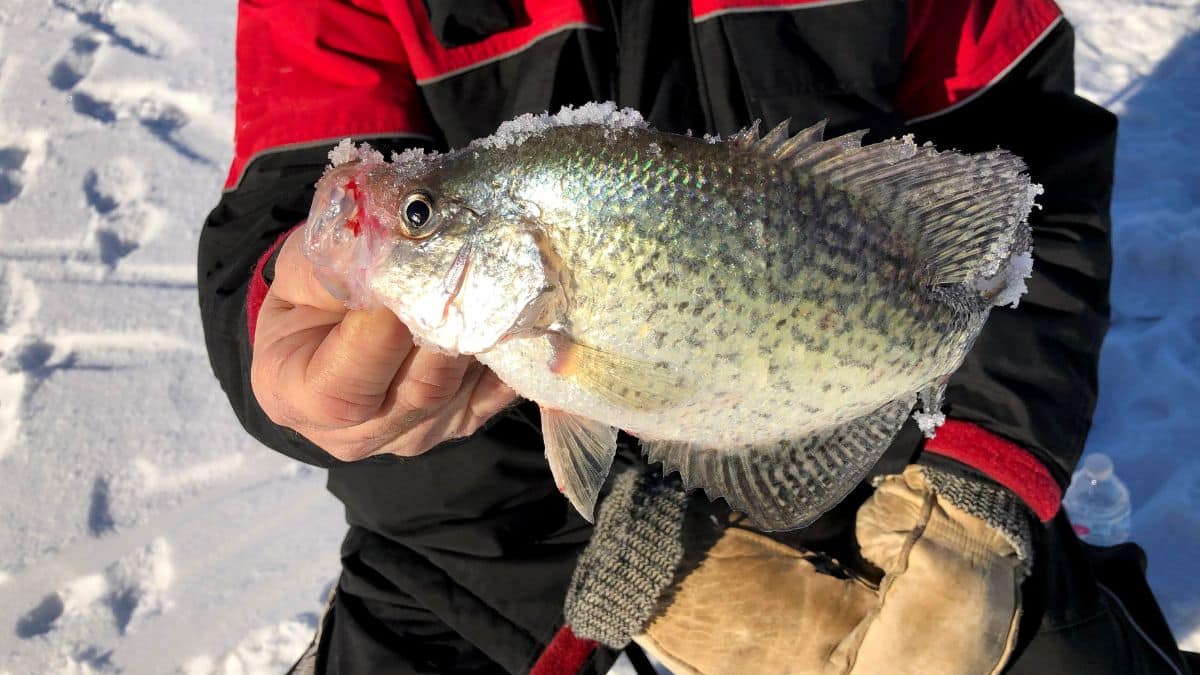
Adding Mobility to Your Ice Fishing Setup
Being mobile on the ice can significantly affect the outcome of your crappie ice fishing experience, especially during the winter months in northern states.
Ice fishermen can maximize their chance of finding big crappie by utilizing a sled to move around easily with their equipment. This allows anglers to try different spots and depths in search of the perfect location.
Remember, crappies move between deeper water and shallower water within the water column throughout the day. Catch crappies by drilling several ice holes near weed beds, humps, or drop-offs in deep and shallow water.
A helpful tip is to focus on shallower water in early ice, while deeper water is more productive during late ice crappie fishing.
Using Specialized Equipment and Accessories
Incorporating electronics, such as fish finders, ice fishing flashers, and underwater cameras, can significantly improve your ability to locate and target crappie during the ice fishing season.
These tools provide insights into the presence of fish, structure, and bottom of the lake, helping you pinpoint the best spots. For optimal results, combine electronics with the use of small jigs, live bait, and artificial lures to attract crappie.
In selecting the right lures, consider tungsten jigs, small spoons, and horizontal jigs as good choices. They sink faster and entice crappie in various water conditions.
Use live bait, such as small minnows, wax worms, crappie minnows, and soft plastic bait, to increase your chances of getting crappie bites. A rule of thumb to remember is to use live bait in murky water and small jigs in clear water.
Maximizing Your Fishing Efficiency
To further enhance your crappie ice fishing techniques, adopting a systematic approach to target both white crappie and black crappie effectively is essential. Optimize your time on the ice by trying the following strategies:
- Drill dozens of holes and focus on the most active fish. Moving from hole to hole can increase your chances of finding and catching crappie.
- Utilize a depth finder and adjust your bait within the strike zone to ensure it remains visible to crappie with excellent eyesight.
- Employ submersible and green lights during night ice fishing, as both white crappie and black crappie are more active during this time, increasing your chances of success.
Remember that while experimenting with new techniques may take some time to master, the rewards can be tremendous. By implementing these advanced ice fishing tips and tricks, you will be well on your way to enjoying a more fruitful and enjoyable crappie ice fishing experience.
Fishing Guide: 11 Best Ice Fishing Jackets
Conclusion: Crappie Ice Fishing Tips
Now that you have learned some of the best crappie ice fishing tips and techniques, you are well-equipped to catch your limit of crappie out on the frozen tundra this ice fishing season.
If you have any questions or comments, please leave them below. We love hearing from our readers and the interesting fishing stories they tell. Until next time Happy Ice Angling!

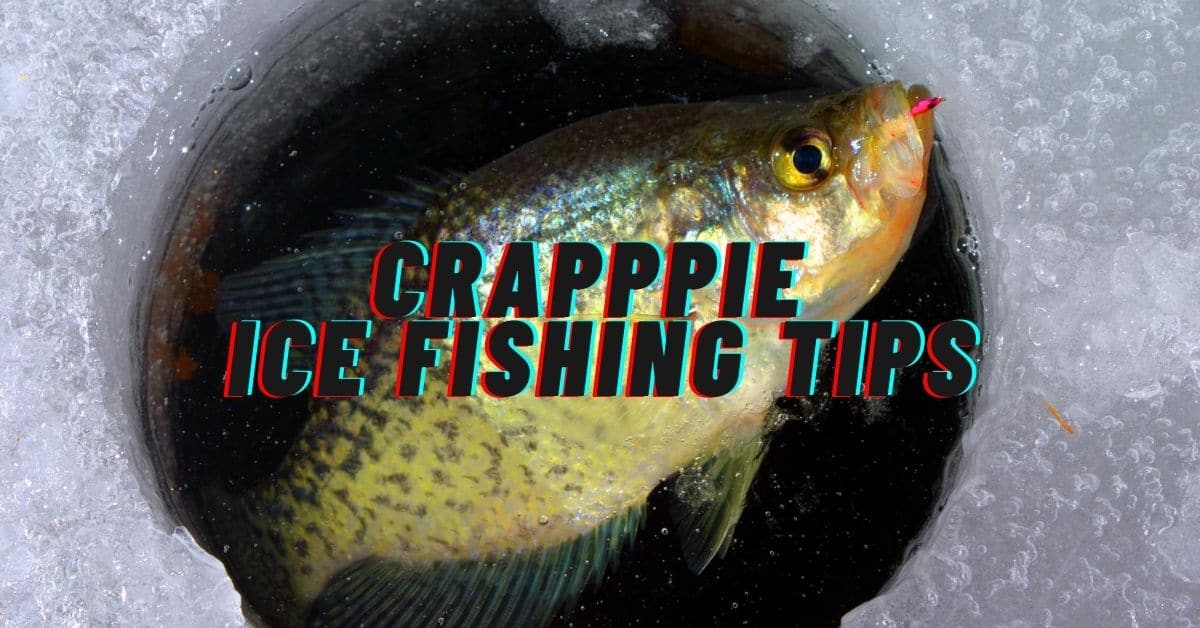
On my last ice fishing trip i was not very successful on catching many crappie. I had my heart set on some and was really disappointed. Good news is i found this post,
I have another trip coming up soon and will definitely implement these 3 tips especially changing the live bait often.
That is one i completely overlooked and never knew about!
Thank you!
You are welcome. Glad I could help.
Hi this is a very good article and I have a couple of friends who love fishing and I am sure if I show them your work they will appreciate it more than I can. I have never tried fishing but am thinking of taking it up soon as a hobby. I will book mark your site for future reference. Thanks, Kenny
Thank you Kenny. Fishing is a fun and relaxing sport. I do recommend you get out and try it.
This is a great article. Unfortunately I have not yet got to fish Crappie because there are none in my part of the country. I am however planning a trip so these tips will help me greatly.
Was wondering a few things. Do they prefer any color over another? And secondly do they usually bite near the bottom, middle or top of the water?
I look forward to hearing your answer.
Dale
The color preference for fish usually depends on much light or lack of it that’s penetrating through the ice and how clean or dirty the water is. If it’s dark you would want to use lighter colored lures if it’s light you want to use darker colored lures. They will bite anywhere they can find food.